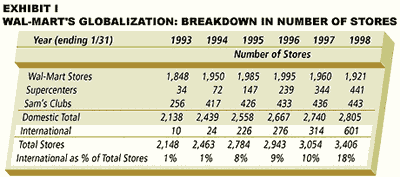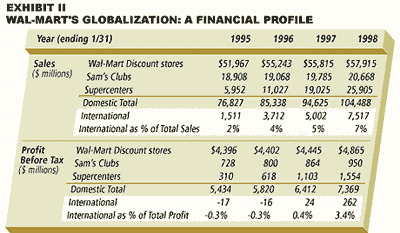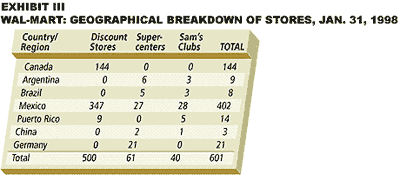Taking Wal-Mart Global: Lessons From Retailing's Giant
How did this retailer go global? By using a strategy of "directed opportunism." And knowing how to clone its corporate DNA.
Becoming global is never exclusively the result of a grand design, though certainly it cannot be the result of incremental, ad hoc, opportunistic and random moves. The wisest approach would be one of "directed opportunism" - an approach that maintains opportunism and flexibility within a broad direction set by a systematic framework.
One of the best examples of the power of an explicit and systematic process to analyze the complex set of factors involved in becoming a global player is Wal-Mart Stores Inc., the largest retailer in the world. The company, which opened its first international store (in Mexico City) in 1991, now operates in all 50 states, Puerto Rico, Canada, China, Mexico, Brazil, Germany, Britain, Argentina and South Korea. Of a work force of more than 950,000, it had more than 130,000 employees working in 729 facilities outside the United States by July 1999.
Until its recent move into supermarkets, the retailer operated three types of outlets: 1) Wal-Mart stores, which offer clothing, linens, small appliances, hardware, sporting goods and similar items; 2) Sam's Clubs, which offer bulk items to customers who purchase warehouse memberships, and 3) Supercenters, which combine the inventories of a discount store with a full-line supermarket.
Wal-Mart has pursued globalization aggressively since its first move across the border in 1991. (See Exhibits I to III.) In 1993 just 1 percent of all Wal-Mart stores were located outside the United States. By 1998, that had grown to 18 percent. Between 1995 and 1998, 5 percent of the company's growth in sales and 4 percent of its growth in profits came from international operations.



Globalization Imperatives
Did Wal-Mart need to go global? Clearly, it had developed a successful business model for competing in the United States. Why not just prosper as an American retailer? The answer is that the company needed to grow in order to survive, and the international arena was the only one in which significant growth was possible.
Why was growth so important? First, the company needed to show increases in both sales and profits to satisfy capital market expectations. Second, it needed to satisfy the expectations of its own employees. One of the key factors in Wal-Mart's success was its dedicated and committed work force. Thanks to Wal-Mart's stock purchase plan, the wealth of these employees was directly tied to the market value of the company's stock, creating a direct link between growth and its effect on stock price and company morale.
Given the necessity for growth, Wal-Mart could not afford to confine its operations to the United States for three reasons. First, it had already saturated most of the domestic markets. Second, the United States accounts for just over 4 percent of the world's population. By limiting itself to this market, Wal-Mart was missing out on 96 percent of the world's potential customers.1 Finally, emerging markets, with their lower levels of disposable income, offered huge platforms for growth in discount retailing. Other companies had already capitalized on such growth thanks to the rapid expansion of information technology, increasing cultural homogenization and lowered trade barriers.2 Wal-Mart had no choice but to pursue globalization aggressively to meet this competition.
In undertaking global expansion, Wal-Mart had the capacity to leverage two key resources originally developed in the United States. It could exploit its tremendous buying power with such giant domestic suppliers as Proctor & Gamble, Hallmark, Kellogg, Nestlé, Coke, Pfizer, Revlon and 3M to procure goods cost-effectively for its non-United States stores. It could also utilize domestically developed knowledge bases and competencies in such areas as efficient store management, the effective use of technology vis-à-vis suppliers, merchandising skills, logistics and I.T. deployment to benefit its foreign outlets. An unforeseen but positive byproduct of this process was that Wal-Mart was also able to leverage sales-generating or cost-reduction ideas learned in its international outlets to benefit its 3,000 United States stores.
Choice of Markets
In going outside the United States, Wal-Mart had the option of entering Europe, Asia or other countries in the Western hemisphere. It could not afford to enter them all simultaneously for at least two reasons. First, in 1991 Wal-Mart lacked the necessary competencies and resources - financial, organizational and managerial.
Second, a logically sequenced approach to market entry allows a company to apply the learning gained from its initial market entries to its subsequent entries.
The choice of which market to enter first is not always easy. During the first five years of its globalization (1991 to 1995), Wal-Mart concentrated heavily on establishing a presence in the Americas: Mexico, Brazil, Argentina and Canada. It is important to examine whether it should have focused first on Europe or Asia instead.
The European market had certain characteristics that made it less attractive to Wal-Mart as a first point of entry. The European retail industry is mature, implying that a new entrant would have to take market share away from an existing player - a very difficult task. Additionally, there were well-entrenched competitors on the scene (e.g., Carrefour in France and Metro A.G. in Germany) that would be likely to retaliate vigorously against any new player. And European retailers have formats similar to Wal-Mart's, neutralizing the competitive advantage Wal-Mart might have expected had its business model been entirely new to the market. Further, as with most newcomers, Wal-Mart's relatively small size and lack of strong local customer relationships would be severe handicaps in the European arena.
Wal-Mart might have overcome these difficulties by entering Europe through an acquisition, but the higher growth rates of Latin American and Asian markets would have made a delayed entry into those markets extremely costly in terms of lost opportunities. In contrast, the opportunity costs of delaying acquisition-based entries into European markets appeared to be relatively small.
It is no doubt true that Asian markets had huge potential when Wal-Mart launched its globalization effort in 1991. But the Asian market is the most distant geographically and the most different culturally and logistically from the United States market. It would have taken considerable financial and managerial resources to establish a presence in Asia.
In the end, Wal-Mart chose as its first global points of entry Mexico (1991), Brazil (1994) and Argentina (1995) - the countries with the three largest populations in Latin America.
By 1996, Wal-Mart felt ready to take on the Asian challenge. It targeted China, with a population of more than 1.2 billion in 640 cities, as the growth vehicle. This choice made sense in that the lower purchasing power of the Chinese consumer offered huge potential to a low-price retailer like Wal-Mart. Still, China's cultural, linguistic and geographical distance from the United States presented relatively high entry barriers, so Wal-Mart decided to use two beachheads as learning vehicles for establishing an Asian presence.
During 1992-93, Wal-Mart agreed to sell low-priced products to two Japanese retailers, Ito-Yokado and Yaohan, that would market these products in Japan, Singapore, Hong Kong, Malaysia, Thailand, Indonesia and the Philippines. Then, in 1994, Wal-Mart entered Hong Kong through a joint venture with the C.P. Pokphand Company, a Thailand-based conglomerate, to open three Value Club membership discount stores in Hong Kong.
Mode of Entry
Once Wal-Mart had selected the country or countries to enter, it needed to determine the appropriate mode of entry. Every company making this move faces an array of choices: It can acquire an existing player, build an alliance with an existing player or start greenfield operations, either alone or in partnership with another player.
Wal-Mart entered Canada through an acquisition. This was a logical move for three reasons. First, Canada is a mature market - an unattractive situation for greenfield operations, since adding new stores (i.e., new capacity) will only intensify an already high degree of local competition. Second, because there are significant income and cultural similarities between the United States and Canadian markets, Wal-Mart faced relatively little need for new learning. Thus, entering through a strategic alliance was unnecessary. Third, a poorly performing player, Woolco, was available for purchase at an economical price. Furthermore, Wal-Mart's business model was precisely what Woolco needed to transform itself into a viable and healthy organization.
For its entry into Mexico, Wal-Mart took a different route. Because there are significant income and cultural differences between the United States and Mexican markets about which the company needed to learn, and to which it needed to tailor its operations, the local market requirements would have made a startup problematic. So, the company chose to form a 50-50 joint venture with Cifra, Mexico's largest retailer, counting on Cifra to provide operational expertise in the Mexican market.
For further expansion in Latin America, Wal-Mart targeted the region's next two largest markets: Brazil and Argentina. The entry into Brazil was also accomplished through a joint venture - with Lojas Americana, a local retailer. But Wal-Mart was now able to leverage its learning from the Mexican experience and chose to establish a 60-40 joint venture in which it had the controlling stake.
The entry into Brazil gave Wal-Mart even greater experience in Latin America, and so it chose to enter Argentina through a wholly owned subsidiary. This decision was reinforced by the fact that there are only two markets in Argentina of significant size.
Cloning the Corporate DNA
Wal-Mart had developed several major capabilities in the United States. Thus Wal-Mart's ability to clone its domestically grown DNA and insert it into its global operations would be a key to success, as illustrated by its entry into Canada.3
Wal-Mart acquired Woolco Canada at a time when a combination of high costs and low productivity had driven the Canadian company into the red. Wal-Mart quickly reconfigured Woolco along the lines of its successful United States model, a strategy facilitated by the similarity between the United States and Canadian markets. This transformation occurred in four central areas:
- Work force: Once the purchase was finalized, Wal-Mart sent its transition team to Canada to familiarize Woolco's 15,000 employees with the Wal-Mart way of doing business. The team was successful in clarifying and defining Wal-Mart's core beliefs and practices to the new Woolco associates.
- Stores: At the time of the sale, many of Woolco's122 stores were in poor shape. Wal-Mart brought every outlet up to its own standards and renovated each plant within three to four months. It took an additional three to four months to restock each store.
- Customers: Although the Woolco acquisition was Wal-Mart's first entry into Canada, the company had a head start in building a consumer franchise because most Canadians live near the United States border and were already familiar with Wal-Mart. Wal-Mart leveraged this high brand recognition into customer acceptance and loyalty by introducing its "everyday low prices" approach to a market accustomed to high/low retail pricing.
- Business Model: A broad merchandise mix, excellent customer service, a high in-stock position and rewarding employees for diminished pilferage were among the United States core attributes that were successfully transplanted into Wal-Mart's Canadian operation.
The transfer of Wal-Mart's corporate DNA to Canada produced dramatic results. Between 1994 (the time of acquisition) and 1997, sales per square foot increased from C$100 to C$292 and market share rose from 22 percent to 45 percent. During the same period, expenses as a percentage of sales in Canada declined by 330 basis points. Wal-Mart's Canadian operation turned profitable in 1996 - only two years after acquisition. By 1997, it had become the leading discount retailer in the country.
Winning the Local Battle
For Wal-Mart, winning the local battle involves two steps:
1. Local adaptation
A company wishing to establish local presence must understand the uniqueness of the local market and decide which aspects of its business model require little change, which require local adaptation and which need to be wholly reinvented. Wal-Mart's entry into China provides insights into this process.4
As the most populous country in the world, China is a major potential market for retailers. Retail sales in China grew at an annual rate of 11 percent between 1990 and 1995, propelled by economic liberalization and a large pent-up demand for consumer goods. But the Chinese market also poses unique challenges because regulations and government policies are often unpredictable and China's infrastructure is not well developed. Also, middle-class disposable income is dramatically lower in China than in the United States, so that even discount-minded Wal-Mart must reinvent its business model to operate within the reach of key population groups. Finally, Wal-Mart had to accept that most Chinese tend to buy in small quantities, and that language differences required tailored marketing approaches for product labeling and brand names.
Wal-Mart responded by conducting a number of experiments. First, it experimented with different store formats to see which had the greatest customer appeal. One was the Shenzhen Supercenter, a hybrid store combining a supercenter and a warehouse club where memberships were sold but non-members could also shop at "everyday low prices" plus a 5 percent premium. The Shenzhen operation also experimented with stocking merchandise targeted at a predominantly male market. Wal-Mart also began testing smaller satellite stores that seemed to fit better with the buying habits, as well as the transportation and shopping trends, in China.
In addition to varied formats, Wal-Mart tested merchandise items to determine what would have the greatest consumer appeal and fit best with the Chinese culture. As a result, Wal-Mart began to carry a wider range of products, particularly perishable goods that appealed to the Chinese palate.
Product sourcing was another area requiring adaptation. Wal-Mart had three options: 1) products obtained from global suppliers; 2) products manufactured in China by global suppliers such as Procter & Gamble, and 3) products from local suppliers. Wal-Mart elected to purchase 85 percent of its merchandise for the Chinese market in China through a combination of options 2 and 3. This solution sought to balance the desire of local customers for high-status United States-made consumer goods and pressure from local governments to purchase domestic goods.
2. Battles with local competitors
Whenever a company enters a new country, it can expect retaliation from local competitors as well as from other multinationals already operating in that market. Successfully establishing local presence requires anticipating and responding to these competitive threats. Wal-Mart has used several approaches to neutralizing local competitors in different markets:
Acquiring a dominant player. Wal-Mart used this approach in its entry into Germany.5 In December 1997, it acquired the Wertkauf hypermarket chain of 21 stores, one of the most profitable hypermarket chains in the country, from the Mann family of Germany. Having determined that building new hypermarkets in Germany would be ill-advised due to the mature European market and that strict zoning laws precluded greenfield operations, Wal-Mart spent more than two years exploring potential acquisitions, including Britain's Tesco, Germany's Metro and the Netherlands' Makro. Wertkauf's stores, similar in format to Wal-Mart's, featured high-quality personnel and locations, and were larger than the average German hypermarket.
Acquiring a weak player. Acquiring a weak player in the local market is an effective approach, provided the global company has the ability to transform the weak player within a very short time. This is what Wal-Mart did in Canada in acquiring Woolco.
Launching a frontal attack on the incumbent. Attacking dominant and entrenched local competitors head-on is feasible only when the global company can bring significant competitive advantage to the host country. Wal-Mart's entry into Brazil illustrates the potential - and the limitations - of a frontal attack.6
Carrefour, the French retailer, had been operating in Brazil since 1975. When Wal-Mart entered Brazil in 1996, it decided to overtake competitors by aggressively pricing its products. This strategy backfired, as Carrefour and other local competitors cut prices as well, leading to a price war and initial losses.
Wal-Mart realized that its global sourcing did not provide any built-in price advantage because the leading sales category in Brazilian supercenters was food items, whose sourcing tended to be local. Competitors such as Carrefour had an advantage in local sourcing because of their long relationships with local vendors.
So Wal-Mart chose to focus on areas where it could differentiate it self: customer service, targeted at neutralizing Carrefour, and merchandise mix, targeted at overwhelming smaller local competitors.
An industry observer remarked: "While small shops in Brazil have a strong customer service component, most large stores, including Carrefour, have adopted the European ethic that the customer is fortunate to have them available and if they are unhappy about something, they are welcome to go next door. To entice shoppers away from these large but user-unfriendly stores, Wal-Mart stressed its customer service, an asset enhanced by its policy for hiring and promotion.7
Speed of Global Expansion
Did Wal-Mart globalize quickly enough? One way to evaluate its speed is to compare the company with other retailers such as J.C. Penney, Kmart and Sears in the United States, and Carrefour and Metro outside the United States. As of 1998, J.C. Penney's global presence was minimal; only three of its 1,200 stores were located outside the United States - in Chile and in Mexico. In 1998, Kmart was a wholly domestic company, deriving all of its sales revenues from its United States stores. As for Sears, its non-United States outlets (all in Canada) were responsible for 8 percent of the company's total 1997 sales revenues of $41 billion. Further, international sales as a percentage of Sears' total sales remained more or less constant from 1995 to 1998. Thus it is clear that Wal-Mart established a global presence at a far more rapid rate than did its three large United States competitors.
A business profile of Carrefour (which announced a merger with fellow French retailer Promodes Group in 1999) is shown in Exhibits IV and V. Carrefour's first international move outside France occurred in 1973, when it entered Spain. It took Carrefour nearly 25 years to build to 79 billion FFr ($15 billion) in international sales. In contrast, Wal-Mart took six years to reach $7.5 billion in international sales. However, a comparison of Exhibit II with Exhibit IV indicates that Carrefour's financial performance in its international operations is better than Wal-Mart's.


In 1998, Metro A.G. was the second-largest retailer in the world, behind Wal-Mart. In 1997, some 7 percent of its total sales were generated outside Germany (compared with 4 percent in 1995 and 5 percent in 1996). As of that year, its degree of globalization was on a par with Wal-Mart's. In 1998, Metro took the major step of acquiring S.H.V. Makro of the Netherlands. Metro's consolidated sales revenues for 1998 are estimated at DM 108 billion, out of which foreign sales would constitute 37 percent. ![]()
Reprint No. 99403
1Merrill Lynch, "Wal-Mart Stores Inc.," March 6, 1998, p. 11.
2Merrill Lynch, "Wal-Mart Stores Inc.," March 6, 1998, p. 12.
3 The Wal-Mart Encyclopedia, Volume III, Salomon Brothers, October 1995, p. 32. "Wal-Mart Stores Inc.," Merrill Lynch, March 6, 1998, pp. 18-19.
4 "Wal-Mart Stores Inc.," Merrill Lynch, March 6, 1998, p. 47. "Wal-Mart International Reshapes the World Retailing Order," Discount Store News, January 20, 1997.
5 "Target Europe," Chain Store Age, March 1998.
6 "Wal-Mart Stores Inc.," Merrill Lynch, March 6, 1998, p. 34. "Wal-Mart International Reshapes the World Retailing Order," Discount Store News, January 20, 1997.
7 "Wal-Mart International Reshapes the World Retailing Order," Discount Store News, January 20, 1997.
|


